Lumbini Nepal: Interesting Facts, Peaceful Culture & Birthplace of Lord Buddha
By Kushal Shrestha - May 1, 2025 | Updated: May 1, 2025 | 14 min read
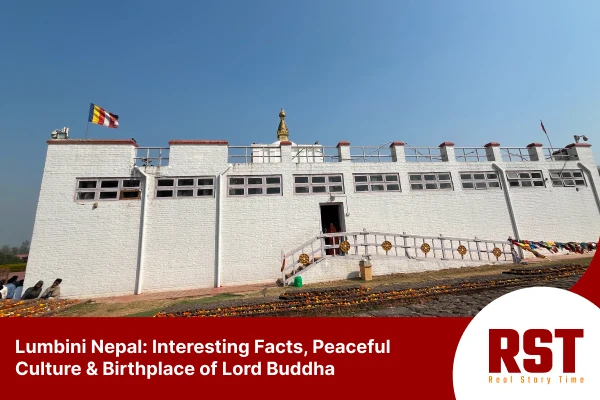
Imagine a place where time is stretched, the air is lighter, and every breeze carries whispers from centuries past. Welcome to Lumbini, Nepal, the birthplace of Lord Buddha and a great peaceful sanctuary for the soul.
Located in the Terai lowlands of southern Nepal, Lumbini is eternally radiant as a sanctuary of tranquility and history, serving as a place for spiritual enlightenment. Having been revered as the birth site of Siddhartha Gautama, later known as Lord Buddha, this serene destination continues to attract pilgrims, historians, and every kind of traveler worldwide.
Acknowledged as a UNESCO World Heritage Site, Lumbini is not just a dot on the map but an overwhelming experience connected through centuries of Buddhist heritage, peaceful monasteries, and a message for the universal practice of compassion and harmony.
From ancient sacred gardens to modern global monasteries, Lumbini in Nepal remains a witness to a culture based on peace and mindfulness.
Whether planning your next journey or being curious about the Buddhist essence, this article will take you closer to experiencing Lumbini tourism in Nepal.
Historical Significance of Lumbini
Nepal’s Lumbini is eternal in human history and holy for all humankind. It is recognized as one of the most revered sites, the origin point of Siddhartha Gautama, who eventually became known as Lord Buddha. This sacred place is of utmost importance to Buddhists everywhere for meditation on the thoughts of kindness and enlightenment. The site has served as a spiritual beacon for over 2,000 years and has a past full of glory intertwined with myth, archaeology, and royal patronage.
The Birthplace of Siddhartha Gautama
In 623 B.C., Buddha was born in the sacred gardens of Lumbini, Nepal, which is still one of the most hallowed places for Buddhists worldwide. Ancient texts tell us that Queen Maya Devi paused under a flowering sal tree in Lumbini while visiting her family’s home. There, amid tranquil natural beauty, was Siddhartha Gautama, the prince destined to be the Enlightened One.
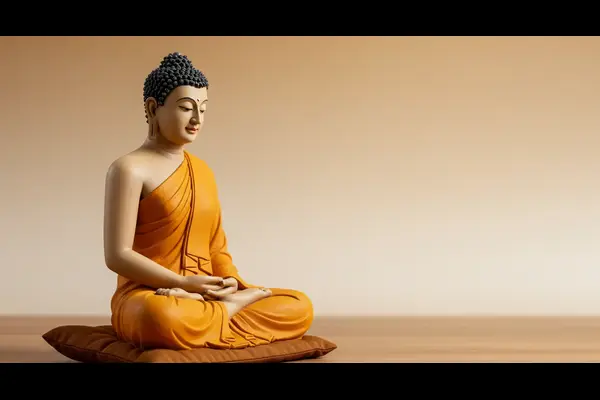
In ancient times, Lumbini in Nepal was not a vibrant city but a serene grove with lush vegetation and peaceful ponds. Such stillness and nurturing surroundings represented what Siddhartha would later preach about: compassion, mindfulness, and inner peace.
UNESCO World Heritage Site Status
In 1997, UNESCO designated Lumbini a World Heritage Site, recognizing its profound spiritual importance as the birthplace of Lord Buddha. UNESCO classified and recognized the site as possessing “outstanding universal value” for its association with Buddha’s life and as a symbol of humanity’s quest for enlightenment and inner peace ever since.
Lumbini, Nepal, has played a key role in enhancing preservation initiatives, archaeological studies, and global awareness regarding its distinctive heritage. Many archaeological surveys by international teams revealed what once were monasteries, stupas, and inscriptions that prove the ancient textual references. The Ashoka Pillar, which was erected during the 3rd century B.C. by Emperor Ashoka of India, is one of the most important discoveries, as it has inscriptions proving the site’s historicity.
Maya Devi Temple: Heart of the Sacred Garden
The Maya Devi Temple in Lumbini, Nepal, serves as the spiritual core of the Sacred Garden and indicates the exact location where Lord Buddha was born. This sacred place is named in honor of Queen Maya Devi, the mother of Siddhartha Gautama, and it is among the most significant sites for preserving relics from the Buddha’s early life.
In the middle of the temple is a sacred marker stone. It marks the place where Buddha is said to have been born. Remains of old monasteries surround it, including the Sacred Pool, where Queen Maya Devi bathed, and the Ashoka Pillar inscription, which emblematically recognized Lumbini as a historical site of Buddha.
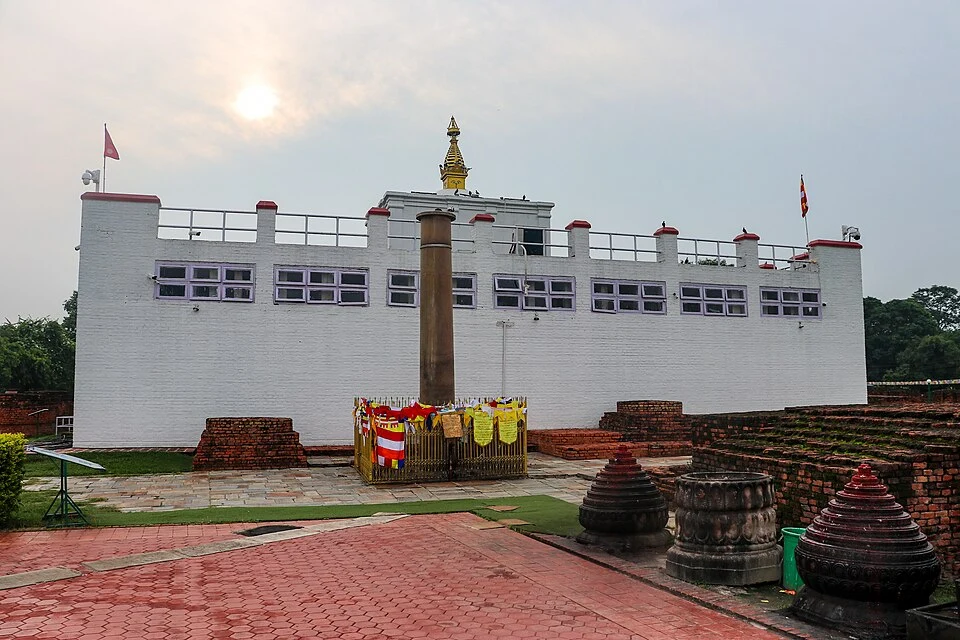
Today’s visitors experience deep spirituality and pure beauty in the Sacred Garden. Enclosed by prayer flags, tranquil ponds, and age-old trees, this peaceful spot encourages contemplation, meditation, and appreciation of the vibrant cultural legacy of Buddhism in Nepal.
The Maya Devi Temple in Lumbini remains a timeless symbol of peace, compassion, and the enduring legacy of Buddha’s teachings.
Ashoka Pillar Inscription: A Testament to History
The sacred nature of Lumbini established itself through direct historical proof when the Indian Mauryan Emperor Ashoka the Great visited in the 3rd century B.C. He then built the Ashoka Pillar as a lasting marker that proclaimed Lumbini as the Buddha’s birthplace. The pillar established by Ashoka continues to show Lumbini’s eternal divine significance.
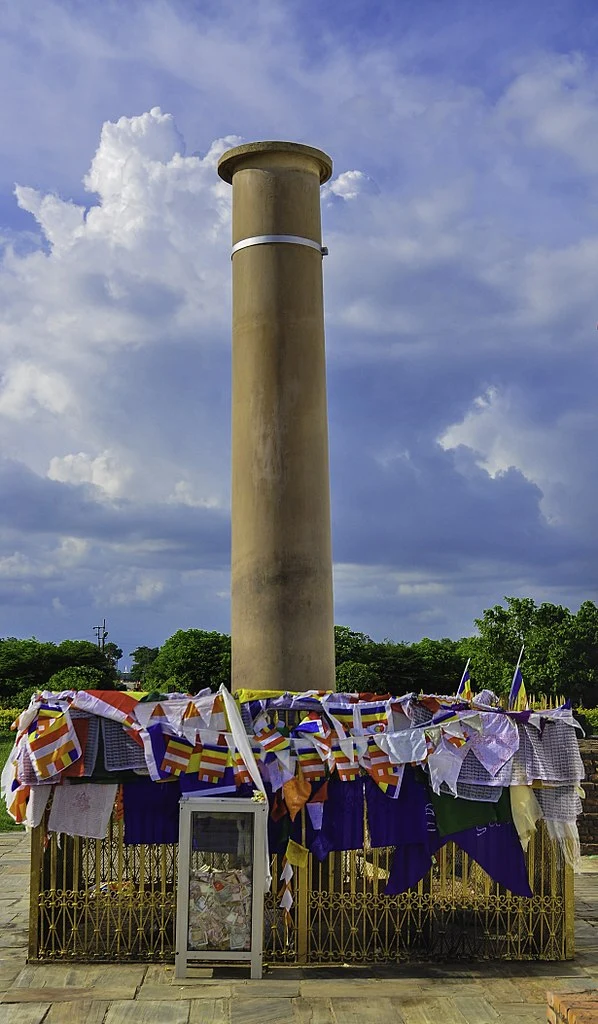
Lumbini today is undoubtedly much more than a mere historical site. It is truly a place where history, spirituality, and peace come together. Visitors from all over the world come here to see where the Buddha first entered the world and feel the deep silence that has graced the ground for over two millennia. The spirit of enlightenment thrives in every whisper of the trees and every stone in the ancient garden.
Puskarni Pond
To the south of the Ashoka Pillar lies the sacred Puskarni Pond. Queen Maya Devi is thought to have bathed in this pond before giving birth to Prince Siddhartha. Some believe that Gautama Buddha received his first purification bath in this pond.
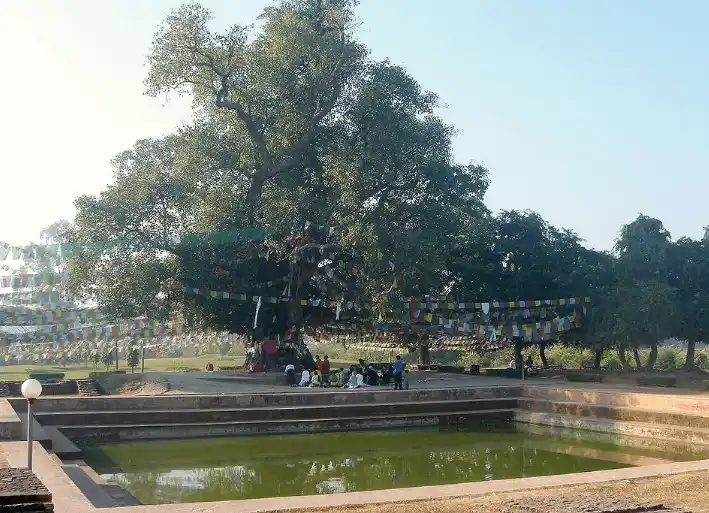
Devotees maintain this tradition by taking a holy dip into the pond to request blessings and spiritual purification. Nestling Puskarni, monasteries, and brick pagodas dating from the 2nd century B.C. to the 9th century A.D. offer an eye-opening example of its history.
For the Buddhist heritage, this holy pool is still alive.
Important Lumbini Buddhist Sites You Must Visit
It is globally recognized as Lord Buddha’s birthplace and has the world’s most sacred, peaceful Buddhist sites. If you’re a pilgrim, tourist, or seeker of peace, you owe it to yourself to discover these must-visit Buddhist sites.
- Sacred Garden
The Sacred Garden outside the Maya Devi Temple is a meditation and contemplation area. The garden features ponds, old trees, and prayer flags that signify sacred peace and spiritual purity.
- Monastic Zone
The Monastic Zone in Lumbini, Nepal, is a tranquil area that hosts Buddhist monasteries from across the globe. It’s divided into two parts:
Eastern Zone: Features calm and simple temples from Theravāda Buddhist countries, including Thailand and Sri Lanka.
Western Zone: The most colorful monasteries, including Mahāyāna and Vajrayāna, are from Tibet, China, Japan, and Germany.
When you stroll through the Monasteries, you’ll feel like you have returned from a pilgrimage worldwide, as each temple mirrors its country’s unique spiritual and cultural style.
The Monastic Zone is a monument for unity, peace, and Buddha’s teaching.
- World Peace Pagoda
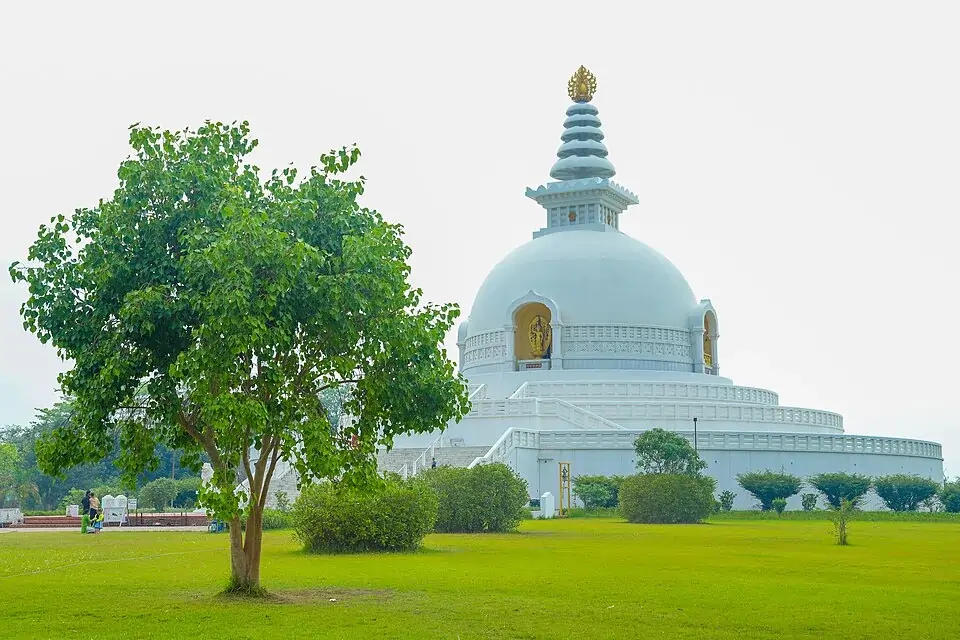
Constructed by the Japanese Buddhist organization Nipponzan Myohoji, the World Peace Pagoda has become an iconic symbol of universal peace and brotherhood, thus becoming one of Nepal’s most popular and photographed sacred sites.
- Lumbini Museum
For those interested in its history, the Lumbini Museum showcases relics, manuscripts, and archaeological objects describing where Buddha was born and the history of Buddhist culture.
- Eternal Flame
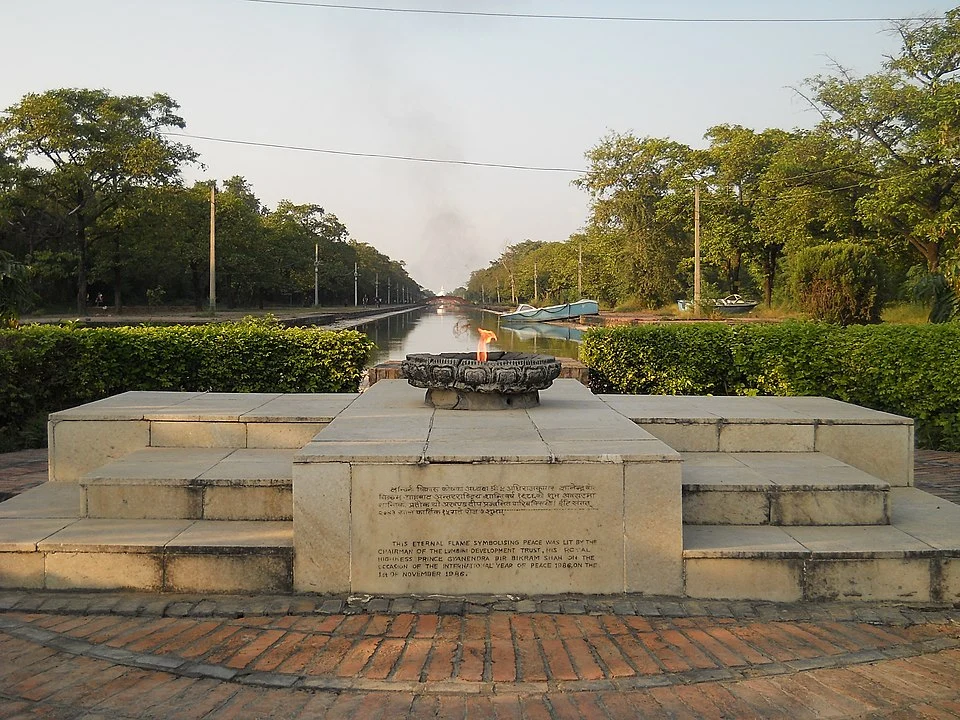
At the southern end of the canal in Lumbini lies the Eternal Peace Flame, one of the major attractions in the Lumbini garden. It was established in 1986 as a monument to the International Year of Peace. It was bought from the United States with funds raised to promote world peace and understanding among world nations and the global community.
Monasteries in Lumbini: A Cultural Mosaic
When you visit Lumbini, you will enter a museum of global Buddhist culture. The Monastic Zone includes an Eastern Monastic Zone (Theravāda Buddhism) and a Western Monastic Zone (Mahayāna and Vajrayāna Buddhism). The architecture and customs of the Buddhist religion from each country are represented in a single mosaic at each monastery.
Here are some of the most intriguing monasteries to make the traveler’s itinerary:
1. Myanmar Golden Temple
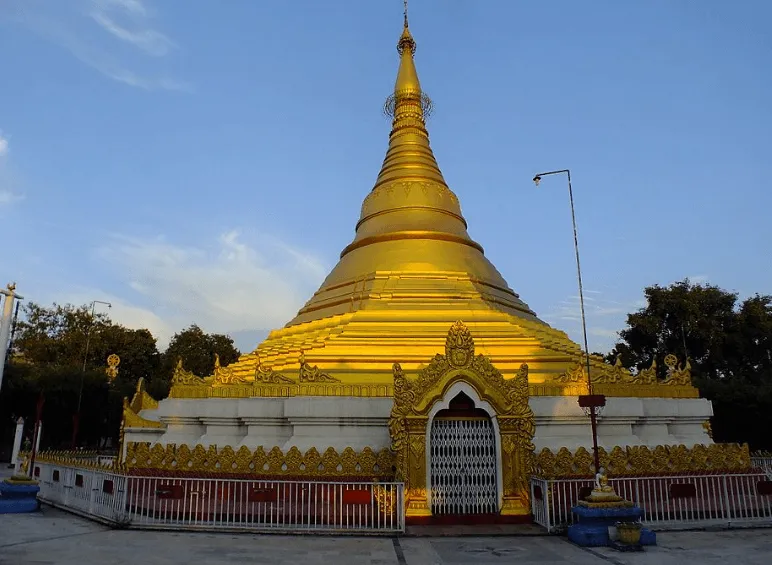
The Myanmar Golden Temple is among the most ancient buildings. Like the renowned Shwedagon Pagoda in Yangon, its impressive spires are gilded. Inside, you’ll find carvings, golden Buddhas, a buzz of devotion, a beautiful model of Burmese Buddhist artistry, and serenity.
Highlights:
- Stunning golden stupas
- Peaceful meditation halls
- Classic Burmese design patterns
2. Royal Thai Buddhist Monastery
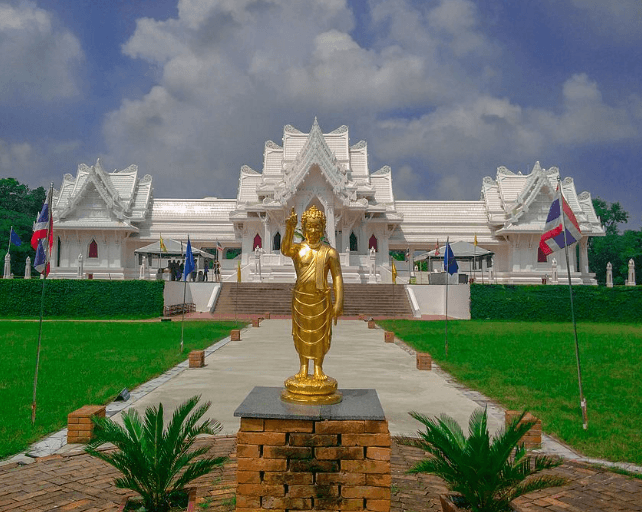
The Royal Thai Temple radiates in a pure white sparkle. The Monastery looks peaceful and elegant, built from white marble adorned with traditional Thai patterns. Its fabulous gardens and symmetrical design make it one of the most photogenic spots in Lumbini.
Highlights:
- Classic Thai-style temple of white marble
- The main chapel has a giant golden Buddha
- They also periodically offer free meditation classes.
3. Great Lotus Stupa
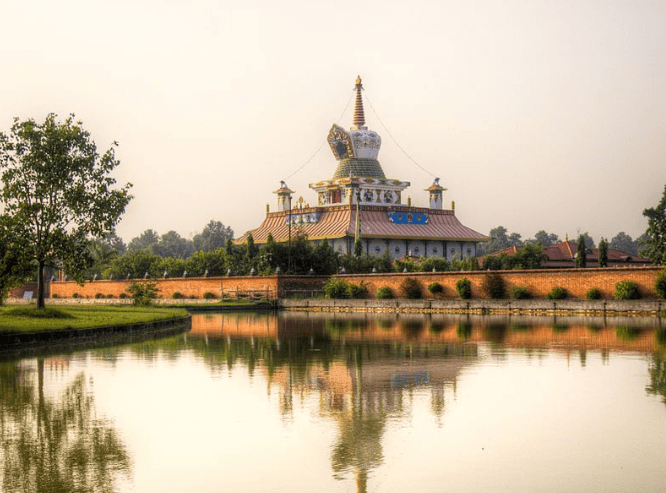
Constructed by the German Dharmaduta Society, the Great Lotus Stupa, also called the German Monastery, embodies simplicity and clarity, principles integral to Zen Buddhism. Encircled by lovingly tended gardens, the stupa is themed on reflection and meditation.
Highlights:
- Minimalist yet strong Zen construction
- Carving of Lord Buddha in meditation
- Quiet atmosphere suited for long meditation sessions
4. Chinese Monastery: Zhong Hua Chinese Buddhist Monastery
The Zhong Hua Chinese Buddhist Monastery also represents the spiritually rich and skilled hand of the Chinese people, spiritually and skillfully, with elegant gestures. The magnificent gates, expansive courtyards, beautiful landscaping, and refined woodwork immediately introduce visitors to the imperial temples of ancient China.
Highlights:
- Lofty grand pagodas with vaunting architecture
- Golden Statuary of Buddha and Bodhisattvas
- Visitors can practice meditation and attend spiritual events
5. Korean Temple: Dae Sung Shakya Sa
Korean monks established the Dae Sung Sakya Sa monastery, which is recognized for its striking green-tiled roofs and richly painted interiors. The temple also offers visitors free guided meditations to experience Korean Seon (Zen) Buddhism.
Highlights:
- Brightly painted Buddhist stories
- Meditations Scheduled
- Traditional Korean Buddha rituals
READ MORE: Who Is Kumari? Meet Nepal’s Living Goddess and Only Living Deity
Buddha’s Early Life and Journey to Enlightenment
Siddhartha was born to Queen Maya Devi and King Suddhodana of the Shakya clan in Lumbini during the 6th century B.C. He is said to have been born under a Sal tree in the Sacred Garden close to the Maya Devi Temple, and many celestial signs attended his birth.
As a boy in the royal palace of Kapilavastu, Siddhartha lived in a world of luxury and ease. His father sought to protect him from life’s harsh realities and denied him access to anything that could cause grief or spiritual questioning. However, Siddhartha’s destiny was not to remain confined within palace walls.
One day, while out, he met the Four Sights: an older man, a sick person, a corpse, and a wandering ascetic. These encounters awakened him to the truth of aging, illness, and death and their search for spiritual release. Siddhartha then knew that a life of luxurious pleasure could not lead to permanent happiness.
At 29, Siddhartha made a vital decision: he gave up his royal title, riches, and newborn son to seek spirituality. Siddhartha had spent six years practicing the most extreme form of asceticism, denying himself comfort and pleasure in his pursuit of enlightenment. Eventually, he discovered that neither luxuriating nor straining far toward deprivation produced the insight that he sought and so turned to the Middle Way, which was regarded as a path of balance.
Ultimately, at 35, when Siddhartha was meditating beneath the Bodhi Tree in Bodh Gaya, he attained enlightenment, only then becoming the Buddha: “the Awakened One.” The revelation of the truth concerning suffering, its cause, and the path to overcoming it became the foundation of what we now know as Buddhist teachings.
From that moment on, Buddha spent the rest of his life teaching others the way to liberation, which was marked by compassion, mindfulness, wisdom, and the possibility of freedom from the cycle of birth and death.
Travel Tips for Visitors
1. Plan your journey: Visit between October and March, the cooler season, to escape the heat and the rain.
2. Dress Properly: Wear light walking shoes and loose, comfortable clothing because, at Lumbini, being a religious place, one appreciates modest dressing.
3. Hydrate Yourself: You can carry a reusable bottle and constantly fill it up, especially when exploring new places.
4. Respect the Customs: Know the local customs and traditions. Always enter temples and worship places barefoot.
5. Exploring the Holy Garden: The Maya Devi Temple is in the Holy Garden, which testifies to Buddha’s Holy Birthplace.
6. Check Out Attractions Nearby: Explore sites like the Lumbini Museum and several monasteries representing different nations.
7. Sample local cuisine: Taste traditional Nepali dishes at local restaurants.
8. Environmental Protection: Help keep Lumbini clean by refraining from littering and utilizing waste disposal areas when required.
9. Look for a Guide: For a better experience, hire a local guide. They could provide more information on the history and importance of the sites.
10. Security: Be observant of your surroundings and safe with your belongings. Although it is relatively safe, it is good to be cautious.
Have an incredible journey to this calm, historical place!
How to Reach Lumbini, Nepal
1. By Air: Gautam Buddha International Airport (GBIA) is the nearest to Lumbini and has regular flights from Kathmandu and Pokhara. It has taxis ready to take you to your accommodation.
2. By Bus: Frequent buses run from Bhairahawa (Siddhartha Nagar), 25 kilometers from Lumbini. You can travel to Bhairahawa by bus or taxi from Kathmandu, Pokhara, or Chitwan and then by local bus or taxi.
3. By Car: You can hire a cab for your journey. Although the roads are pretty good, the conditions vary. Traveling from Kathmandu to Lumbini takes about 8-10 hours, and about 5-6 hours from Pokhara.
4. Local Transportation: In Lumbini, Nepal, bicycles, rickshaws, and taxis are the primary transportation modes. Tourists often prefer bicycles to explore the Sacred Garden and monastic zones at their own pace in a serene environment.
Conclusion: The Timeless Message of Peace and Compassion
Lumbini is a timeless testament to peace, compassion, and the pursuit of truth in a world full of haste and chaos. Walking in its sacred place, you can almost hear the whisper of history and feel the echoing footsteps of the Buddha.
Lumbini provides something special regardless of whether you’re a pilgrim looking for spiritual growth, a traveler pursuing history, or a soul looking for peace. It’s not merely where Lord Buddha was born, but a light of hope symbolizing human beings’ never-ending pursuit of enlightenment.
If you want a trip that engages the mind and heart, prioritize Lumbini on your travel map.
FAQs About Lumbini
1. Why is Lumbini considered a sacred place for Buddhists?
Siddhartha Gautama, also known as Lord Buddha, was born in Lumbini, Nepal, in 623 B.C. According to old scriptures and the inscriptions on the Ashoka Pillar, the purity connected with it renders it one of the holiest pilgrimage sites for Buddhist communities worldwide.
2. Can non-Buddhists or international tourists visit monasteries?
Indeed, it is open to all faiths. Visitors can explore monasteries, participate in guided meditations, or admire the beautiful architecture and the serene environment. It is advisable to behave respectfully and dress modestly.
3. Is there an entrance fee?
Of course, it uses a fee that is not too high, such as an entrance fee, for the maintenance and preservation of the site. The charged fee may change occasionally, so you are encouraged to find out the current rate before visiting.
4. How many monasteries are there in Lumbini?
The Monastic Zone presents over 30 monasteries from different nations, such as Thailand, Myanmar, China, Germany, Korea, and Nepal. Each monastery showcases its distinct architectural style and interpretation of Buddhist principles.
5. Are there any cultural events or festivals in Lumbini?
Lumbini observes several festivals, the most important of which is Buddha Purnima. It is celebrated on a full moon day in either April or May and is said to mark Buddha’s birth, enlightenment, and death. It features prayers, processions, meditation, and cultural performances from the Buddhist community.
6. Is it suitable for solo or spiritual travelers?
It is suitable for both solo and spiritual travelers. Tranquil ambiance, meditation programs, and the presence of the international Buddhist community constitute a secure and meditative arena for self-discovery and spiritual practices.
Notice an error?
Help us improve by submitting a correction.







